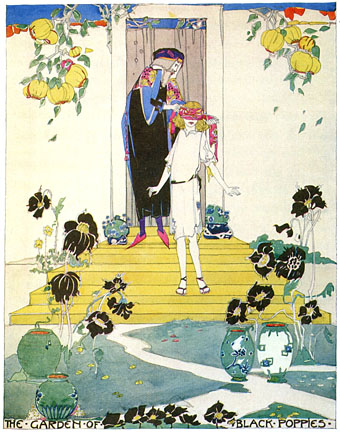Illustration from The House of Pomegranates (1914) by Jessie M. King.
Continuing an occasional series. Recent Wildean links.
• It’s a measure of a writer’s success if the characters or stories they create resonate sufficiently with future generations to be subject to new interpretations. Among Oscar Wilde’s contemporaries this has happened to Arthur Conan Doyle and Bram Stoker, both of whom Wilde knew. Increasingly it’s been happening to Wilde’s own fiction, especially in the case of Dorian Gray whose tragedy assumes the status of a modern myth. At Cannes this year, Clio Barnard premiered a contemporary retelling of Wilde’s The Selfish Giant. Bleeding Cool has some clips. The social realism is a long way from Wilde’s tale but that shows how flexible these fables can be.
• Jessie M. King’s illustrations for Wilde’s The House of Pomegranates have appeared here before but the copies posted at The Golden Age are the usual quality scans.
• Rick Gekoski: “Visiting the US, I am reminded of Oscar Wilde’s tour there in 1881, which allowed him to become an orator and a celebrity.”
• Paper Dolls by David Claudon based on the characters from The Importance of Being Earnest. (Thanks to Gabe for the tip.)
Elsewhere on { feuilleton }
• The Oscar Wilde archive


Hey John, I know I’ve mentioned this series before but “A House of Pomegranates” with the Jessie M. King illustrations has recently been published by Dover as a part of the Calla Edition collection.
Here’s a link to the page if you’d like to check it out. http://store.doverpublications.com/1606600214.html
(I do not work for Dover. Just enthusiastic about nice books. :/)
I’ve always thought that Wilde’s fairy tales were superior to Dorian Gray and I still think “The Fisherman and His Soul” is one of my personal favorite stories of all time.
I keep forgetting about those Dover books so it’s good to be reminded.
Dorian Gray is a good idea with sloppy execution, although there are brilliant sequences throughout. He wrote it hastily, and the tone is very uneven: you’ve got the initial premise veering into chapters that want to be like Huysmans’ À Rebours, a sequence that’s all dialogue like one of his plays, some unconvincing female love interest at the end, then the end itself which is very rushed. It still works because of the central idea (which is what people continue to interpret), and the degree to which Wilde’s personality and obsessions shine through. There are many novels from the same period which are more technically accomplished but none of them have the lasting resonance of Dorian Gray.
John,
I’ve heard rumors of Bram Stoker having a tryst with Wilde as well as with Whitman. Any thoughts on that?
Wilde and Bram is one I’ve not heard before. Maybe someone was scrambling the genuine connection via Florence Stoker, Bram’s wife. Oscar was engaged to Florence before she met Bram when they were both still living in Dublin.
I think Oscar met Whitman when he was in the US (he did meet Longfellow) but from what I recall his meetings with poets were all pretty formal. He was being followed by the US press so was on his best behaviour.
another curiosity:
When Bram met Walt
That’s interesting. People make much of the Henry Irving influence on Dracula–Penguin even used a photo of Irving for one edition–but that’s the first time I’ve seen any suggestion that Whitman might be present in the novel in some way.